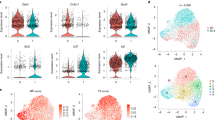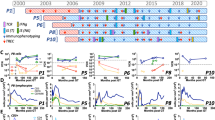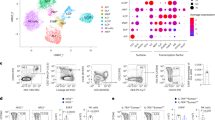Abstract
The variegated expression of murine Ly49 loci has been associated with the probabilistic behavior of an upstream promoter active in immature cells, the Pro1 element. However, recent data suggest that Pro1 may be active in mature natural killer (NK) cells and function as an enhancer element. To assess directly if Pro1 transcripts are present in mature Ly49-expressing NK cells, RNA-sequencing of the total transcript pool was performed on freshly isolated splenic NK cells sorted for expression of either Ly49G or Ly49I. No Pro1 transcripts were detected from the Ly49a, Ly49c or Ly49i genes in mature Ly49+ NK cells that contained high levels of Pro2 transcripts. Low levels of Ly49g Pro1 transcripts were found in both Ly49G+ and Ly49G− populations, consistent with the presence of a small population of mature NK cells undergoing Ly49g gene activation, as previously demonstrated by culture of splenic NK cells in interleukin-2. Ly49 gene reporter constructs containing Pro1 failed to show any enhancer activity of Pro1 on Pro2 in a mature Ly49-expressing cell line. Taken together, the results are consistent with Pro1 transcription having a role in gene activation in developing NK, and argue against a role for Pro1 in Ly49 gene transcription by mature NK cells.
This is a preview of subscription content, access via your institution
Access options
Subscribe to this journal
Receive 6 digital issues and online access to articles
$119.00 per year
only $19.83 per issue
Buy this article
- Purchase on SpringerLink
- Instant access to full article PDF
Prices may be subject to local taxes which are calculated during checkout






Similar content being viewed by others
References
Vivier E, Tomasello E, Baratin M, Walzer T, Ugolini S . Functions of natural killer cells. Nat Immunol 2008; 9: 503–510.
Lanier LL . NK cell recognition. Annu Rev Immunol 2005; 23: 225–274.
Saleh A, Makrigiannis AP, Hodge DL, Anderson SK . Identification of a novel Ly49 promoter that is active in bone marrow and fetal thymus. J Immunol 2002; 168: 5163–5169.
Kubo S, Nagasawa R, Nishimura H, Shigemoto K, Maruyama N . ATF-2-binding regulatory element is responsible for the Ly49A expression in murine T lymphoid line, EL-4. Biochim Biophys Acta 1999; 1444: 191–200.
Gosselin P, Makrigiannis AP, Nalewaik R, Anderson SK . Characterization of the Ly49I promoter. Immunogenetics 2000; 51: 326–331.
Wilhelm BT, McQueen KL, Freeman JD, Takei F, Mager DL . Comparative analysis of the promoter regions and transcriptional start sites of mouse Ly49 genes. Immunogenetics 2001; 53: 215–224.
Saleh A, Davies GE, Pascal V, Wright PW, Hodge DL, Cho EH et al. Identification of probabilistic transcriptional switches in the Ly49 gene cluster: a eukaryotic mechanism for selective gene activation. Immunity 2004; 21: 55–66.
Tanamachi DM, Moniot DC, Cado D, Liu SD, Hsia JK, Raulet . Genomic Ly49A transgenes: basis of variegated Ly49A gene expression and identification of a critical regulatory element. J Immunol 2004; 172: 1074–1082.
Rouhi A, Gagnier L, Takei F, Mager DL . Evidence for epigenetic maintenance of Ly49a monoallelic gene expression. J Immunol 2006; 176: 2991–2999.
Rouhi A, Brooks CG, Takei F, Mager DL . Plasticity of Ly49g expression is due to epigenetics. Mol Immunol 2007; 44: 821–826.
Kubo S, Itoh Y, Ishikawa N, Nagasawa R, Mitarai T, Maruyama N . The gene encoding mouse lymphocyte antigen Ly-49: structural analysis and the 5′-flanking sequence. Gene 1993; 136: 329–331.
Gays F, Koh AS, Mickiewicz KM, Aust JG, Brooks CG . Comprehensive analysis of transcript start sites in Ly49 genes reveals an unex- pected relationship with gene function and a lack of upstream promoters. PLoS One 2011; 6: e18475.
Gays F, Taha S, Brooks CG . The distal upstream promoter in Ly49 genes, Pro1, is active in mature NK cells and T cells, does not require TATA boxes, and displays enhancer activity. J Immunol 2015; 194: 6068–6081.
Mason L, Giardina SL, Hecht T, Ortaldo J, Mathieson BJ . LGL-1: a non-polymorphic antigen expressed on a major population of mouse natural killer cells. J Immunol 1988; 140: 4403–4412.
Sentman CL, Hackett J, Kumar V, Bennett M . Identification of a subset of murine natural killer cells that mediates rejection of Hh-ld but not Hh-lb bone marrow grafts. J Exp Med 1989; 170: 191–202.
Hanke T, Takizawa H, McMahon CW, Busch DH, Pamer EG, Miller JD et al. Direct assessment of MHC class I binding by seven Ly49 inhibitory NK cell receptors. Immunity 1999; 11: 67–77.
Orr MT, Murphy WJ, Lanier LL . 'Unlicensed' natural killer cells dominate the response to cytomegalovirus infection. Nat Immunol 2010; 11: 321–327.
MacFarlane AW IV, Yamazaki T, Fang M, Sigal LJ, Kurosaki T, Campbell KS . Enhanced NK-cell development and function in BCAP-deficient mice. Blood 2008; 112: 131–140.
Forbes CA, Scalzo AA, Degli-Esposti MA, Coudert JD . Ly49C-dependent control of MCMV Infection by NK cells is cis-regulated by MHC Class I molecules. PLoS Pathog 2014; 10: e1004161.
Brennan J, Lemieux S, Freeman JD, Mager DL, Takei F . Heterogeneity among Ly-49C natural killer (NK) cells: characterization of highly related receptors with differing functions and expression patterns. J Exp Med 1996; 184: 2085–2090.
Guia S, Jaeger BN, Piatek S, Mailfert S, Trombik T, Fenis A et al. Confinement of activating receptors at the plasma membrane controls natural killer cell tolerance. Sci Signal 2011; 4: ra21.
Vosshenrich CA, García-Ojeda ME, Samson-Villéger SI, Pasqualetto V, Enault L, Richard-Le Goff O et al. A thymic pathway of mouse natural killer cell development characterized by expression of GATA-3 and CD127. Nat Immunol 2006; 7: 1217–1224.
Renard V, Ardouin L, Malissen M, Milon G, Lebastard M, Gillet A et al. Normal development and function of natural killer cells in CD3 epsilon delta 5/delta 5 mutant mice. Proc Natl Acad Sci USA 1995; 92: 7545–7549.
Gays F, Martin K, Kenefeck J, Aust JG, Brooks CG . Multiple cytokines regulate the NK gene complex-encoded receptor repertoire of mature NK cells and T cells. J Immunol 2005; 175: 2938–2947.
Makrigiannis AP, Rousselle E, Anderson SK . Independent control of Ly49g alleles: implications for NK cell repertoire selection and tumor cell killing. J Immunol 2004; 172: 1414–1425.
Anderson SK, Dewar K, Goulet ML, Leveque G, Makrigiannis AP . Complete elucidation of a minimal class I MHC natural killer cell receptor haplotype. Genes Immun 2005; 6: 481–492.
Gays F, Unnikrishnan M, Shrestha S, Fraser KP, Brown AR, Tristram CM et al. The mouse tumor cell lines EL4 and RMA display mosaic expression of NK-related and certain other surface molecules and appear to have a common origin. J Immunol 2000; 164: 5094–5102.
Horton RM, Cai Z, Ho SM, Pease LR . Gene splicing by overlap extension: tailor-made genes using the polymerase chain reaction. Biotechniques 1990; 8: 528–535.
Di Santo JP . Natural killer cell developmental pathways: a question of balance. Annu Rev Immunol 2006; 24: 257–286.
Barao I, Alvarez M, Ames E, Orr MT, Stefanski HE, Blazar BR et al. Mouse Ly49G2+ NK cells dominate early responses during both immune reconstitution and activation independently of MHC. Blood 2011; 117: 7032–7041.
Stulberg MJ, Wright PW, Dang H, Hanson RJ, Miller JS, Anderson SK . Identification of distal KIR promoters and transcripts. Genes Immun 2007; 8: 124–130.
Cichocki F, Hanson RJ, Lenvik T, Pitt M, McCullar V, Li H et al. The transcription factor c-Myc enhances KIR gene transcription through direct binding to an upstream distal promoter element. Blood 2009; 113: 3245–3253.
Martianov I, Ramadass A, Serra Barros A, Chow N, Akoulitchev A . Repression of the human dihydrofolate reductase gene by a non-coding interfering transcript. Nature 2007; 445: 666–670.
Trinklein ND, Aldred SF, Hartman SJ, Schroeder DI, Otillar RP, Myers RM . An abundance of bidirectional promoters in the human genome. Genome Res 2004; 14: 62–66.
Dobin A, Davis CA, Schlesinger F, Drenkow J, Zaleski C, Jha S et al. STAR: ultrafast universal RNA-seq aligner. Bioinformatics 2013; 29: 15–21.
Liao Y, Smyth GK, Shi W . The subread aligner: fast, accurate and scalable read mapping by seed and vote. Nucleic Acids Res 2013; 41: e108.
Law CW, Chen Y, Shi W, Smyth GK . voom: Precision weights unlock linear model analysis tools for RNA-seq read counts. Genome Biol 2014; 15: R29.
Acknowledgements
This project has been funded in whole or in part with federal funds from the National Cancer Institute (NCI), National Institutes of Health (NIH), under Contract No. HHSN261200800001E. This research was supported in part by the Intramural Research Program of the NIH, NCI, Center for Cancer Research.
Disclaimer
The content of this publication does not necessarily reflect the views or policies of the Department of Health and Human Services, nor does mention of trade names, commercial products or organizations imply endorsement by the US Government.
Author information
Authors and Affiliations
Corresponding author
Ethics declarations
Competing interests
The authors declare no conflict of interest.
Rights and permissions
About this article
Cite this article
McCullen, M., Li, H., Cam, M. et al. Analysis of Ly49 gene transcripts in mature NK cells supports a role for the Pro1 element in gene activation, not gene expression. Genes Immun 17, 349–357 (2016). https://doi.org/10.1038/gene.2016.31
Received:
Revised:
Accepted:
Published:
Issue date:
DOI: https://doi.org/10.1038/gene.2016.31



